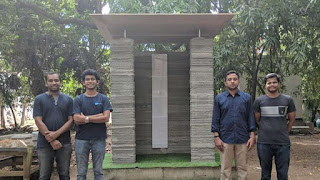Can a home be built in just Five Days?
April 27,2021 – India’s first 3D-Printed home was set up in IIT-Madras by the start-up “TVASTA Manufacturing Solutions”, within the campus, in association with Habitat for Humanity’s Terwilliger Centre for Innovation in Shelter.
 |
| India's first 3D Printed house created in IIT Madras. |
Over the years, even though,at a slow pace, the technology of 3D-Printed houses has started overruling the traditional way of constructing houses globally. About a dozen companies are working on 3D-printed houses worldwide, with an estimation to reach at a total cost of $1.5 billion by 2024 globally.
History states that the construction of 3D printing and its development has been underway since 1995. Two methods were invented, one by Joseph Pegna which was focused on a sand/cement forming technique. The other technique, Contour Crafting by Behrohk Khoshnevis, initially began as a novel ceramic extrusion and shaping method, as an alternative to the emerging polymer and metal 3D printing techniques, and was patented in 1995.
“Designing a building to be 3D printed is still a challenge as most designers are unfamiliar with the requirements of the technology,” says Sansom. But as truly quoted – Nothing is Impossible.
With an increase in pollution and CO2 emissions, there is
a need for a house building technology which is affordable. 3D printing
technology uses organic and Eco-friendly materials such as Cellulose and Sand,
to build single-storey houses, thus reducing both construction and labour cost.
Due to the cost reduction, it can be a great aid for
people in poverty-stricken regions or after natural disasters. Construction using
3D printers can finish a home’s foundation in 3-4 days, while traditional
construction methods take at least 4-5 weeks of time.
 |
| A prototype of 3D printing process |
Today’s 3D printers are likely to work with locally
accessible materials that would increase the sustainability of construction. This
results in less emission of waste, reduced pollution and minimal wastage of
material.
Different types of structures require a different set of
processes and machinery.
One of them is a Robotic Arm Extruder and
is similar to how FDM desktop 3D printers work. The rails are arranged to let
the robotic arm move; and within the limits of the rails, the arm
will build the house layer by layer by extruding concrete material from the
nozzle. This is the most popular 3D printing technology used to build XL structures.
 |
| Robotic Arm Extruder |
The next 3D technique is more similar to industrial 3D printing such as SLS or Jet Fusion. The pioneer who tested it is the Italian architect Enrico Dini, who built his D-Shape 3D printer. The machine spreads a layer of sand powder and then hardens the shape of the structure with a binder. This is exactly how our metal 3D printers work too!
Last but not least, for structures such as bridges,
which have to withstand more stress, Dutch company MX3D developed
Wire Arc Additive Manufacturing (WAAM). The team described the technology as,
“We combined an industrial robot with a welding machine to turn it into a 3D
printer that works with our software”. The robot allows for 3D printing metal
structures in 6-axes.
“Transporting building materials long distances to disaster relief zones, typically hard to reach areas, can be a lengthy exercise. By using locally accessible materials, even sand, a portable 3D printer can be delivered to site and reduce the time required to build the homes that are urgently needed.”
Right now, this approach to construction remains very
niche – only a handful of 3D printed house and office prototypes
exist around the world. Nevertheless, it represents an exciting and potentially
profound change in how we build.
A few of them are mentioned below.
Dubai municipality office building, UAE
In December 2019, 3D printing robot firm Apis Cor
announced it had completed the world’s largest individual 3D printed
building. The office block, built in the UAE, is 9.5 metres in height and has a
floor area of 640 m2.
Office of the Future, UAE
Another impressive 3D printed building in the UAE was the
Office of the Future. For this building, the printing itself was done offsite,
with all the parts printed in 17 days. Workers installed the whole building in
just 48 hours.
3D printed houses by WinSun, China
Chinese 3D printing firm WinSun also uses
factory-based 3D printers to construct human dwellings. The firm has created a
handful of home designs, including a small apartment block. The design’s users
can quickly and cheaply print the parts before installing them on-site.










Comments
Post a Comment